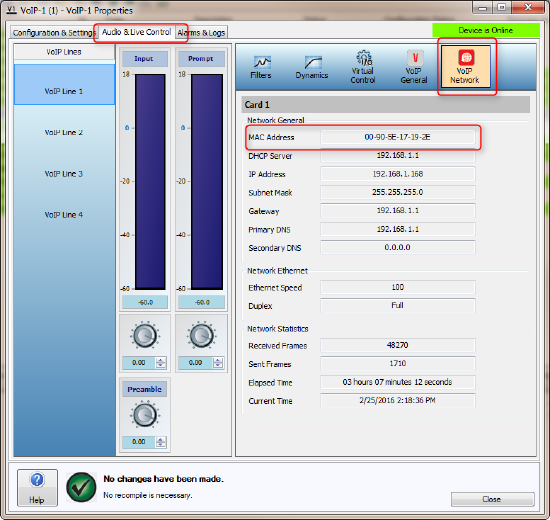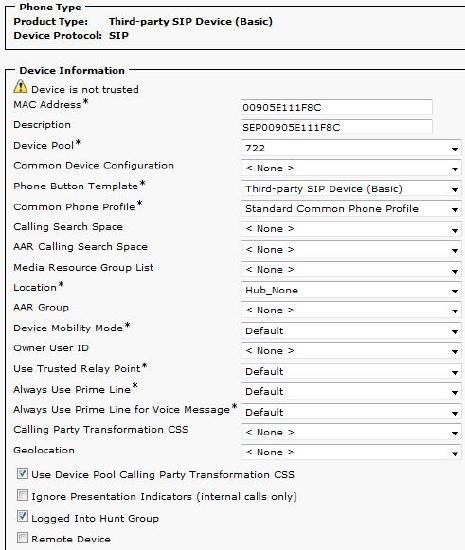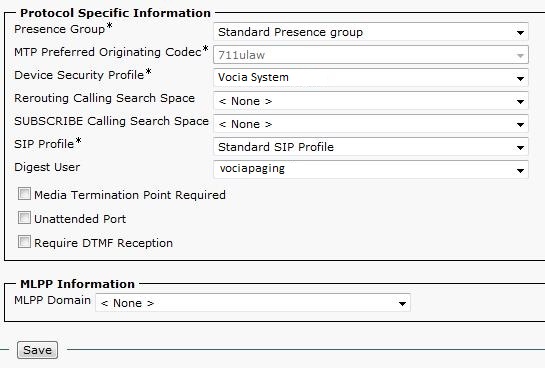Cisco Call Manager Configuration for Vocia VoIP-1
Biamp’s VoIP-1 allows Biamp Vocia systems to utilize Voice-over-IP (VoIP) systems that adheres to the SIP (Session Initiation Protocol) standard. The interface permits live, real-time paging using any page code within the Vocia system using the VoIP telephone extension as the paging source. The VoIP-1 is available with one or two VoIP network ports. Each port will support up to two lines. This document details the steps required to configure a Cisco Call Manager VoIP system to work with Biamp’s VoIP-1. For information regarding the parameters not covered in this article, please refer to the Vocia help.
Preliminary steps
Before configuring the Call Manager system, there is some information that needs to be obtained. First, note the MAC address of the VoIP-1. To do this, first connect to the configured Vocia system using the Vocia software. Then, double-click on the VoIP-1 that is located with in the Audio Inputs folder in each World. Once open, select the Audio & Live Control tab and then select the VoIP Network icon to display the current network information of the VoIP-1. The MAC address is listed in the MAC Address field shown in the image.
Note that you must be connected live to the system in order to view this information. If you have a second VoIP port (VoIP-1-4) you will have a separate MAC address listed for each card.
Cisco changed license policy from version 9.0 onwards, so the below is not relevant for newer versions. But older versions required that the Call Manager system has enough licenses available to handle a VoIP-1. From CallManager’s perspective, each port on a VoIP-1 appears as a third party SIP endpoint. Cisco required that a sufficient quantity of licenses be purchased from them before a third party SIP endpoint can be integrated into the Call Manager system. To confirm this, log in to the Call Manager system, and go to System—>Licensing—>License User Report. If you plan to use the VoIP-1 card for a single extension, you will need 3 available licenses. If you plan to use the VoIP-1 card for two separate extensions, you will likely need 6 available licenses. A VoIP-1-4 will require twice the number of licenses if both ports are utilized. If unsure, please contact Cisco to confirm how many licenses are required for your application. .
Cisco configuration
First, we'll focus on setting up the Cisco Call Manager server.
Security Profile
The first step to setting up the Call Manager system is to create a Security Profile. If your Call Manager system already has an existing Security Profile that you'd like to use, you may be able to skip this step, although you should confirm that the existing Security Profile has the settings described below. Follow the steps below to create a Security Profile:
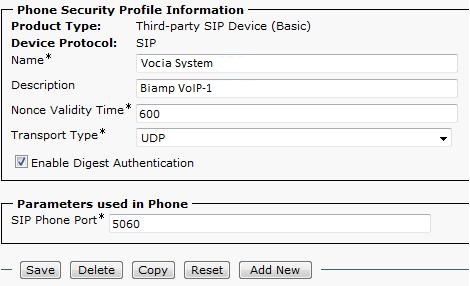 Go to System—>Security—>Phone Security Profile.
Go to System—>Security—>Phone Security Profile.- Click the Add New button.
- Select the Phone Security Profile Type
- If you plan to use the VoIP-1 card for a single extension, choose Third-party SIP Device (Basic).
- If you plan to use the VoIP-1 card for two separate extensions, choose Third-party SIP Device (Advanced).
- Click the Next button.
- Enter a name and a description for the new Security Profile.
- Leave the Nonce Validity Time at its default value of 600.
- Set the Transport Type to either UDP or TCP (but not both). The default Transport type for the VoIP-1 is UDP. Take note of the transport type used, as it will be used later as the Transport setting in the VoIP-1.
- Click the checkbox to Enable Digest Authentication.
- Leave the SIP Phone Port at its default value of 5060 unless your particular situation requires SIP traffic to be transmitted on a different port. If this is the case, you'll need to specify this port in the VoIP-1 as well.
- Click the Save button.
Add a new user
Once a suitable Security Profile has been created, a new user must be created. Follow the steps below to create a new user:
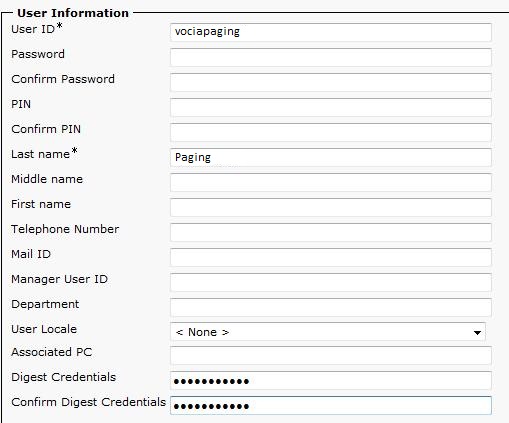 Go to User Management—>End User.
Go to User Management—>End User.- Click the Add New button.
- Enter a user ID. Take note of this User ID, as it will be used later as the "Authentication User Name" in the VoIP-1 configuration.
- The password and PIN number are not required.
- Enter a Last Name (this name is for internal descriptive purposes only).
- Enter a password in Digest Credentials. Take note of the Digest Credentials password, as it will be used later as the “Authentication Password” in the VoIP-1.
- Enter the same password in Confirm Digest Credentials.
- The remaining fields on this page can be left either blank or at their default values.
- Click the Save button.
Add a new device
Once a new user has been created, a new device must be created. This device will link to the Security Profile and the user created in earlier steps. Follow the steps below to create a new device:
|
|
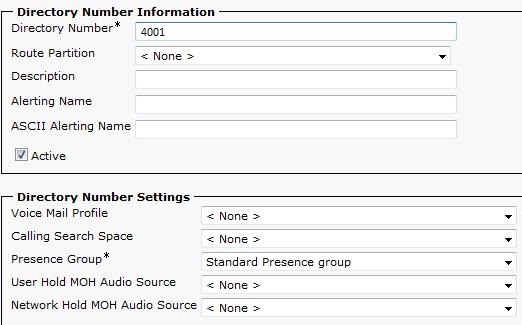 |
- Go to Device—>Phone.
- Click the Add New button.
- Select the Phone Type.
- If you plan to use the VoIP-1 for a single extension, choose Third-party SIP Device (Basic).
- If you plan to use the VoIP-1 for two separate extensions, choose Third-party SIP Device (Advanced).
Note that the Third-party SIP Device (Advanced) setting allows up to 8 lines, but the VoIP-1 uses a maximum of 2 lines. This results in a "partially registered" message from Call Manager. This is normal and not a cause for concern.
- Click the Next button.
- Input the MAC Address of the VoIP-1. Note that the colons should not be included in the MAC Address (see screenshot).
- The Description field will auto-populate once the MAC Address has been entered.
- Select the desired Device Pool in which this device should be included. Ensure that the codec used by this device pool is supported by the VoIP-1 (the VoIP-1 supports the following codecs: G.722, G.711μ, G.711A, G.729AB, and G.723.1).
- The remaining fields under the Device Information heading can be left at their default values.
- For the Device Security Profile, choose the Security Profile created earlier.
- For SIP Profile, choose Standard SIP Profile.
- For the Digest User, select the User created earlier.
- The remaining fields under the Protocol Specific Information and MLPP Information headings can be left at their default values.
- Click the Savebutton.
- Once your information is saved, you will be brought back to the configuration page for the device you just created. The only difference will be that there is an new “Association Information” section in the top left corner. If you’re in Basic (single extension) mode, you should see one line here. If you’re in Advanced (two extensions) mode, you should see up to 8 lines here.
- Click on Line [1] - Add a new DN.
- Enter the directory number for this extension. Take note of the directory number, as it will be used later as the SIP User Name in the VoIP-1 settings.
- Set both the Maximum Number of Calls and Busy Trigger fields to 1.
- The remaining fields on this page can be left at their default values.
- Click the Save button.
- If you’re setting up a 2-line configuration, click on Line [2] - Add a new DN and repeat steps 16-19 above. Otherwise, the Call Manager setup is complete.
One additional note: if the Cisco VoIP system is configured to use Session Refresh Timers, it is important to ensure that the refresh time is set to a value that is higher than the maximum page length set in Tesira. Otherwise, long pages can get cut off prematurely.
VoIP-1 configuration
Next, we'll focus on setting up the VoIP-1 to match the settings that were used in Call Manager.
VoIP-1 Properties
Finally, after all Call Manager settings have been entered, follow the steps below to set up the VoIP-1:
| Biamp VoIP-1 | Cisco Call Manager | |
| SIP Extension | = | Directory Number |
| Authentication User Name | = | User ID |
| Authentication Password | = | Digest Credentials |
- Open the Vocia software, and connect to your system.
- Double-click on the VoIP-1 that is located in the Audio Inputs folder of your World. At the top of the window, the Configuration & Settings tab should be selected.
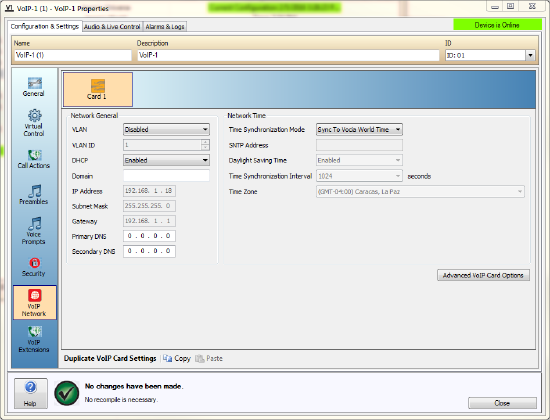 Select the VoIP Network icon located on the left side of the window.
Select the VoIP Network icon located on the left side of the window.- Under the Network General section in the Properties Sheet, set VLAN to Enabled if your VoIP network uses a tagged VLAN. If the network uses an untagged VLAN or no VLAN, leave this value as Disabled. If VLAN is enabled, enter the correct VLAN ID.
- Under the Network General section, leave DHCP set to Enabled if the VoIP-1 will obtain an IP address automatically from a DHCP server. Otherwise, set it to Disabled, and manually enter an appropriate static IP Address, Subnet Mask, and Gateway for the device.
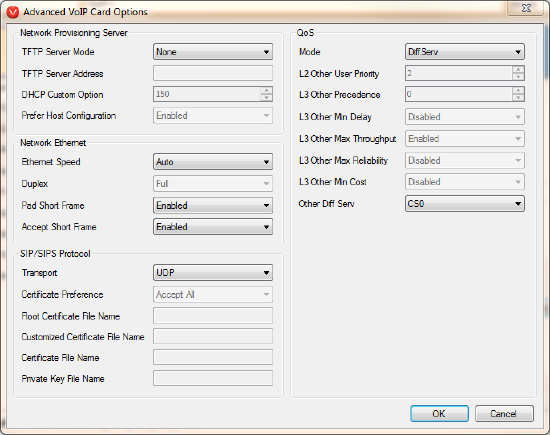 Select the Advanced VoIP Card Options button to open the advanced settings window.
Select the Advanced VoIP Card Options button to open the advanced settings window.- Under the SIP/SIPS Protocol section, ensure that Transport is set to the same transport type you used in the Call Manager settings (see “Security Profile”, step 7).
- Configure any other options as necessary in this window and click the OK button to close the window.
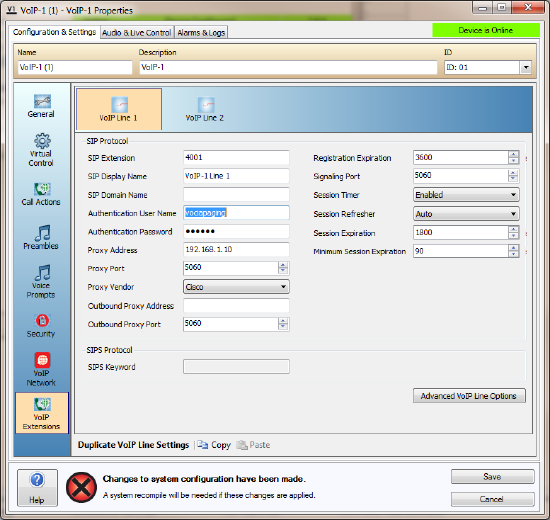 Select the VoIP Extensions icon located on the left side of the window.
Select the VoIP Extensions icon located on the left side of the window.- Select the appropriate VoIP line at the top that is to be configured.
- In the SIP Extension field, enter the Directory Number you used in the Call Manager settings (see “Add a New Device”, step 16).
- In the SIP Display Name field, optionally enter a name for the extension for Caller ID purposes. Note that this name may be overridden by the proxy server, and therefore may not show up as the Caller ID name.
- In the Authentication User Name field, enter the user ID you used in the Call Manager settings (see “Add a New User”, step 3).
- In the Authentication Password field, enter the Digest Credentials you used in the Call Manager settings (see “Add a New User”, step 6).
- Select Cisco as the Proxy Vendor.
- In the Proxy Address field, enter the IP address of the Cisco Call Manager server. If you have separate Subscriber and Publisher servers, enter the IP address of the server that will act as the active registrar for end point devices. It is also worth stating that at this time VoIP-1 dos not support Cisco server redundancy and will only register to a single server. If a failover occurs the VoIP-1 will continuously register to the primary Cisco unit and the connection will heal upon this devices return.
- Custom RTP, QoS, and NAT features are configured by selecting the Advanced VoIP Line Options button. If your network prioritizes VoIP traffic using Quality of Service (QoS), select the QoS tab and enter the appropriate settings for your network. Otherwise, skip this step. By default, only the Diffserv attributes are available. If you prefer specifying QoS using TOS, select TOS as the QoS mode from the Advanced VoIP Card Options and return to this page.
- If you’re configuring multiple lines, select the line at the top of the page and repeat steps 8-14.
- All other settings can remain at their default values in most cases.
- Once all changeds have been made, you must send the system configuration. Send the system configuration to the Vocia system (Network—>Send Configuration to System). Once the configuration is loaded, the VoIP-1 will attempt to register with the proxy server. You can check the status by opening the VoIP-1 properties page and selecting the Audio & Live Control tab. Select the VoIP General icon at the top check the SIP Registered field for the current registration status.


